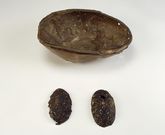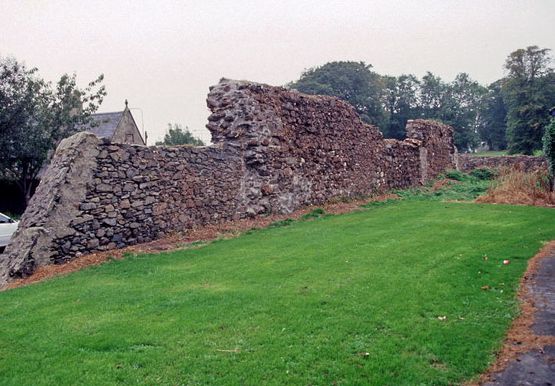Ballyholme
The grave found at Ballyholme in 1903 contained a pair of bronze brooches, a bowl, fragment of chain and some textile.
The brooches are known as oval brooches, one of the best-known types of Viking artefacts. Oval brooches have been studied extensively and it is possible to date them approximately, based on their form. The brooches from Ballyholme are a type which date to the later ninth century, and similar examples have been found in Dublin. Oval brooches were worn by women and were used to fasten the straps of their dresses at the shoulders.
Although the human remains were not retained with the artefacts, it is probable that this was the burial of a female. Oval brooches have almost always been found with female burials while weapons such as swords and spearheads are exclusive to male interments.
A re-examination of the original report of the discovery has led to a re-interpretation of the grave as a possible boat burial. The original report states:
Quote: There was a perpendicular cutting in the sand about 9 feet in depth, where the diggers came on a place where the earth was quite black and V-shaped. The black earth was sharply defined from the dark-red sand: the blackness commenced about 2 feet from the surface, and continued for 6 feet down, narrowing as it went down wedge-shaped. The two brooches were found at the bottom of the cutting, the hollow sides face to face.
The burial was situated immediately above the shoreline, about 2km from the famous early Medieval monastery at Bangor, which was raided by Vikings in 823 and 824. The Annals record that in 824 Vikings plundered the monastery, destroyed the oratory and killed a number of scholars and ecclesiastics and shook the relics of its founder, St. Comhgall, from the shrine.
Ballyholme Bay is a sheltered bay and studies have suggested that it is one of the best landing places on Belfast Lough and would therefore have made a good location for a Viking base. It is possible that the burial was associated with a Viking settlement in the area.
The grave was discovered during landscaping for a housing development. The area in which the burial was found has now been incorporated into the modern town of Bangor.
Ballyholme
In 1903 a grave containing a pair of bronze brooches, a bowl, fragment of chain and some textile were discovered at Ballyholme, near Bangor, Co. Down.
The Vikings in Ireland as elsewhere in Europe were not Christianised until the late tenth century. Their burial customs were pagan and the wealthiest were buried with their personal belongings. The distribution and content of pagan Viking burials in Ireland are valuable indicators of the nature of the earliest contact between the Vikings and Ireland. The largest number of burials is from Dublin, principally from the Viking Age cemeteries of Islandbridge and Kilmainham, the latter being one of the largest cemeteries known in the western Viking World.
Outside of Dublin, Church Bay on Rathlin Island is the only other probable Viking cemetery in Ireland. Other single burials include male burials at:
- Larne
- Co. Antrim
- Eyrephort, Co. Galway
- Barnhall, Co. Kildare
Female burials are known from Ballyholme, Co. Down, near Arklow, Co. Wicklow and at Navan, Co. Meath. While some of these may simply represent an isolated burial, others may be indicative of some form of Viking settlement in the vicinity. From the distribution of pagan Scandinavian burials in Ireland, it can be inferred that Scandinavian activity in the early Viking age was mostly a coastal phenomenon, and that the east coast, particularly the Dublin area, was probably of most significance in this context.
By: Maeve Sikora, National Museum of Ireland
Literature
McErlean, T., McConkey, R. and Forsythe, W. 2002. Strangford Lough. An archaeological survey of the maritime landscape.

